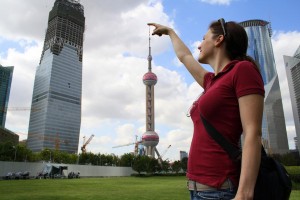Top Ten Things We’ll Miss About China
We leave China today. Here is a list of the top ten things we’ll really miss about China:
- Drinking in Public. While this may seem like a silly thing to miss, in reality being able to drink outdoors is a fun experience. Sitting in the park with a beer is much nicer than sitting there with a Frisbee. We also think the cops in the USA should focus on bigger problems. Naturally, we’re still against drinking and driving, but drinking and walking– we think most people can handle that.
- Cheap food. Surprisingly, food in Shanghai is extremely expensive and diverse. You can find fine dining here to rival New York, but the prices are comparable. What we’ll miss is the street food. For 2RMB you can get a whole stick of lamb meat. At 2am, there is nothing better than lamb kebab.

Window Washers
- Diversity. In the year we lived in Shanghai we were friends with Americans, Brits, Frenchmen, Russians, Ecuadorians, Finnish, Germans, Turkish, Swiss, Chinese, folks from Aruba and more. In a year of living in Saint Paul, MN, we were friends with only Americans. We will really miss the diversity here and it was great fun knowing people from all over the world.
- Travel. Moving around within China is easy. The train system is set up to move millions, and is clean and efficient. There are endless possibilities for travel here and whenever we had time we jumped on a train or boat out of the city with endless destination options. Even with only a free weekend, there were unexplored water towns near Shanghai for a quick escape.
- Work. While the rest of the world is feeling the crunch of the financial crisis the expats in China are doing alright. While I was laid off from my bank job, there were other opportunities for me in China. Meanwhile, I was unemployed in the USA with literally no options or prospects. I will miss the ease associated with job hunting in China.
- Transportation. In Shanghai, getting around was a cinch. The elaborate subway network could get you nearly anywhere in the city for 4RMB. Meanwhile, a plethora of buses honked around on the main streets which you could jump on for 2RMB each way. If all else fails there are cabs dotting the entire city for 11RMB to start and going up to about 30RMB for a trip across the entire town in rush hour traffic. Much easier than owning a car.
- Bartering. While this annoys many expats, I loved bartering. I like setting the price of an item in my mind and then thinking, “I’ll pay anything up to this number for this item.” Thinking like that helped me to prioritize what I needed versus what I wanted. I even enjoy the exchanges between the seller and the buyer with each playing their part as if rehearsed.
- Our Guards. We lived in two apartments in Shanghai and both had an amazing group of guards who protected
the building entrance and doorways. In our first apartment we brought the guards gifts on Chinese holidays. They were always happy to see us and fun to be around. In our second apartment we dropped off beer one evening for them and they never stopped smiling and waving at us after.
- Our Ayi. An Ayi is a cleaning lady. Ours was named Xiao Xu, from Anhui province. She was a very sweet lady who was recommended to us from friends. She was the most patient person I have ever met and she listened to me fumble through my Chinese trying to talk to her and then patiently, and slowly, responded. How she didn’t slap me in the face with the wet mop after the thousandth time I mispronounced something is beyond me.
- Expat lifestyle. This is definitely a great lifestyle. We had a great little apartment in a great area surrounded by easy transportation, cheap and yummy local food, a maze of pubs, endless activities and sights and a modernizing and growing city to watch. Meanwhile, we made decent money and had some amazing friends.
So, as we chug away on our train today, it will be a bitter sweet good-bye as we remember the things we’ll miss, but look forward to the excitement of the road ahead.
















